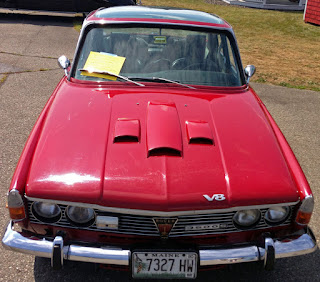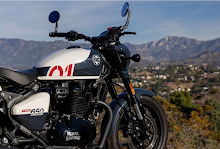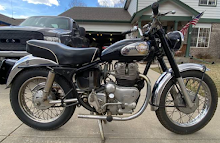 |
1951 Studebaker shown by Bob and Nancy Stover of Belfast, Maine.
Not a museum piece, but it suggests the whimsy of the Owls Head Museum. |
NOTE: The prestigious 2019 New England Auto Auction is 9 a.m. to 5 p.m. Friday and Saturday, Aug. 16-17, at the Owls Head Transportation Museum in Maine. The auction catalog includes more than 200 automobiles and motorcycles and automobilia.
To be honest, the wonderful thing about the
Owls Head Transportation Museum in Maine is not the
1922 Royal Enfield Model 200 motorcycle on display there.
The wonderful thing is the way this museum pulls together all that stuff you dreamed about as a kid: roaring through the air in a World War I Sopwith biplane, blasting down the road in a classic MG, or showing up your friends in a really neat kiddie car.
Our visit Aug. 4 was special because there was a car show and air show at the museum that day. Some of the cars and plane we saw aren't there every day.
But any day at this museum would be a blast. Literally a blast. The museum is dotted with genuine antique bulb horns you're invited to TOOT!
 |
| 1913 Rubes horn. The Rubes brothers started making horns in Brooklyn in 1904. |
How fun is that?
 |
| Early MG sports cars line an entire wall of the museum. |
I love vintage planes and antique motorcycles, but the fantastic collection of MG cars at Owls Head really caught my eye. It's not all the MGs, but it certainly includes a lot of the interesting ones. The core of this assemblage is The Cobb Collection, loaned to the museum by Dick and Dottie Cobb.
 |
| 1932 MG J2 is a noticeably small car, almost childlike in size. |
The museum's Morris Garage line-up starts with the 1932 MG J2. MG had just turned racing's handicapping system on its head, proving that displacement wasn't the only thing that counted. A light car could take on more powerful cars. This J2 is small, even noticeably smaller than the other MGs here. You wanted your J2 with all the racing accessories, including bonnet straps.
 |
| MG L1 Magna's ride was likened to a mountain goat. |
The 1933 MG L1 Magna, produced only that year, was just one of the bewildering number of variations MG produced from 1929 to 1936 — more body styles than in any other period. It came with a six-cylinder motor and you could get it with a supercharger. And look: even a back seat!
 |
| 1933 MG L1 Continental Coupe; based on a sports car, the back seat was unusable. |
The 1933 MG L1 Continental Coupe is an odd ball. It encumbered the sleek MG with an enclosed body, preferred by MG principal Cecil Kimber. It became known as "Kimber's Folly." Only 100 were built and they sold slowly. The sliding sunroof, with oval windows, provided both light and ventilation but was hardly attractive doing either.
 |
| 1934 MG PA, stylish in red. |
The 1934 MG PA here and the PB that followed were considered by some the "last of the Midgets" because later models replaced the overhead camshaft with pushrod motors. Was this the beginning of MG fans considering each new model (which would go on to build its own fan base) a betrayal?
 |
1946 MG TC, the car that started the sports car craze in America
even though it was only ever made with right-hand drive. |
The 1946 MG TC appeared only five weeks after the end of World War II, and they sold well, with 10,000 produced. These were the cars American service members saw, and introduced the United States to British sports cars. The museum's TC is equipped with a "30 light." This is a light on the dash alerting the driver he has reached 30 mph, a common limit in England.
 |
| 1937 MG VA, big, prestigious, but not fast enough. |
The 1937 MG VA shown elsewhere in the museum was meant as competition for Jaguar. It had expensive looking style, but only a four-cylinder motor. How wonderful that it even existed.
Here are other interesting things I spotted at the museum and in a car show held there Aug. 4:
 |
1970 Rover 3500S V8 with transparent roof,
shown by Garrett Bourque of Jefferson, Maine. |
 |
| Rover offered this option but owner knows of only one other in existence. |
 |
| Magnificent rear end of 1959 Plymouth Sport Fury. |
 |
| A Curtiss JN-4 Jenny, right? Well, no... |
 |
| That was just a model. A real 1917 Jenny is behind it. |




































No comments:
Post a Comment